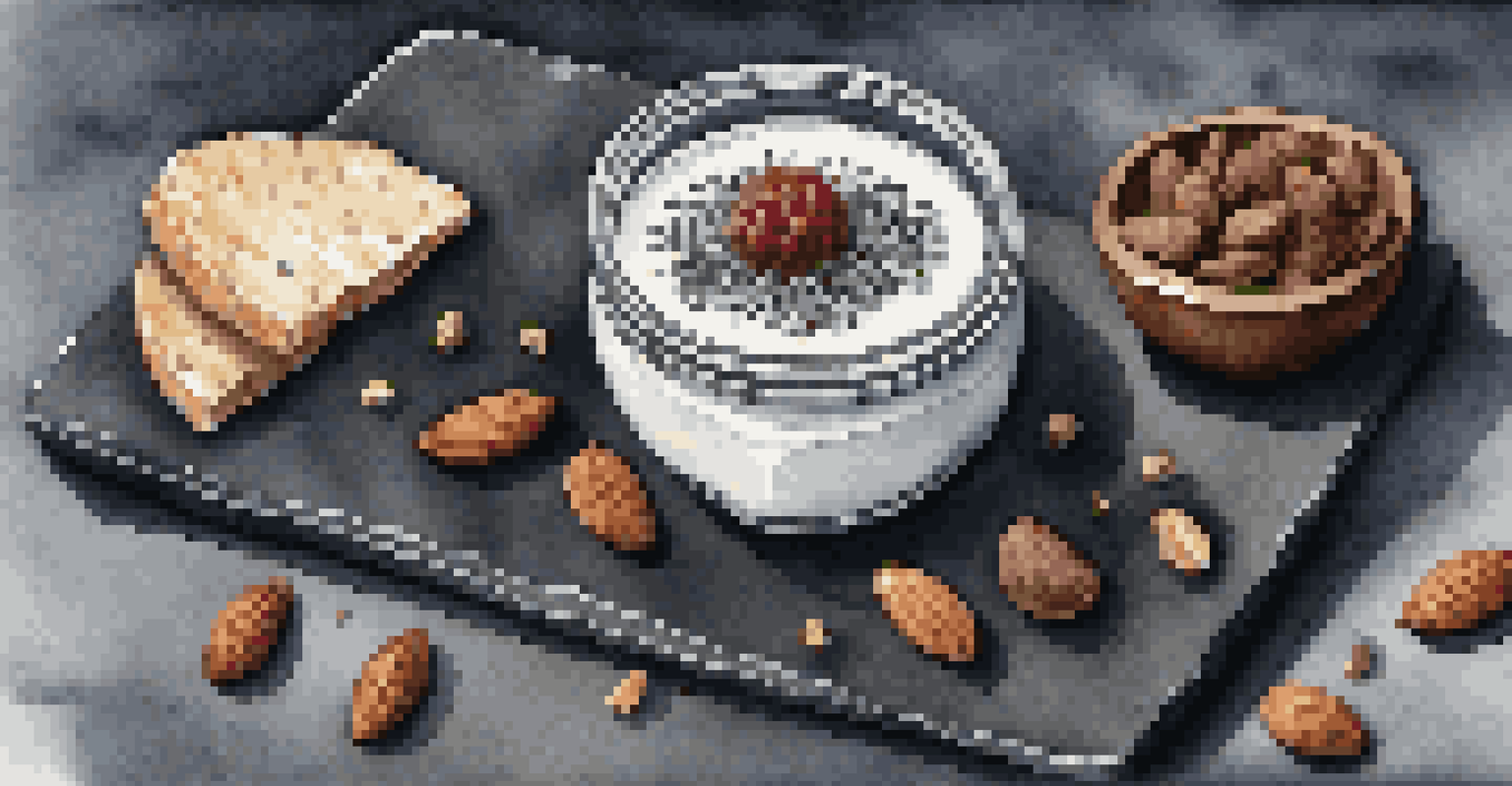Healthy Fats: Their Importance in a Dancer's Diet

Understanding Healthy Fats and Their Role
Healthy fats, often referred to as unsaturated fats, are vital for overall health and especially important for dancers. These fats can be found in foods like avocados, nuts, seeds, and olive oil. Unlike saturated fats, which can raise cholesterol levels, healthy fats support heart health and provide long-lasting energy. For dancers, incorporating these fats into their diet can enhance performance and stamina during rigorous practice and performances.
Let food be thy medicine and medicine be thy food.
In a dancer's diet, healthy fats serve multiple purposes. They help in the absorption of fat-soluble vitamins A, D, E, and K, which are crucial for maintaining optimal health. Furthermore, these fats provide a concentrated source of energy, helping dancers to fuel their bodies for extended periods of activity. When dancers think about their diet, including healthy fats is not just a choice; it's a necessity for sustained energy.
However, it's important to balance the intake of healthy fats with other macronutrients like carbohydrates and proteins. A well-rounded diet ensures that dancers get the right combination of nutrients to support their rigorous training schedules. By understanding the benefits of healthy fats, dancers can make informed choices about what to include in their meals for optimal performance.
The Benefits of Healthy Fats for Dancers
One of the primary benefits of healthy fats for dancers is improved energy levels. Unlike quick-burning carbohydrates, healthy fats provide a steady release of energy that can sustain dancers through long rehearsals or performances. This is especially beneficial when they need to maintain energy during demanding routines that require both strength and endurance.

Moreover, healthy fats contribute to muscle recovery post-performance. They play a crucial role in reducing inflammation and repairing muscle tissue, which is essential for dancers who often push their bodies to the limit. Foods rich in omega-3 fatty acids, like salmon and walnuts, can be particularly effective in this regard, helping dancers bounce back stronger after intense training sessions.
Healthy Fats Boost Energy Levels
Incorporating healthy fats provides a steady release of energy, essential for sustaining dancers through long rehearsals and performances.
In addition to physical benefits, healthy fats also support mental clarity and focus. This can be incredibly valuable for dancers who need to remember choreography and maintain concentration during their performances. A well-nourished brain can lead to better decision-making and performance on stage, making healthy fats a key player in a dancer’s diet.
Incorporating Healthy Fats into Daily Meals
Incorporating healthy fats into meals can be simple and delicious. For breakfast, consider adding avocado to toast or blending nut butter into smoothies. Both options provide a healthy dose of fats while also being satisfying and energizing, perfect for starting the day on the right foot.
The food you eat can either be the safest and most powerful form of medicine or the slowest form of poison.
For lunch and dinner, salads are a great way to include healthy fats. Toss in olive oil-based dressings, sprinkle seeds or nuts, or add fatty fish like mackerel or salmon. These additions not only enhance the flavor of the meal but also provide essential fats that fuel a dancer's body for practice or performance.
Snacking is another opportunity to add healthy fats to a dancer's diet. Options like a handful of almonds, Greek yogurt with chia seeds, or dark chocolate can satisfy cravings while providing energy. Making these small adjustments to meals and snacks can significantly improve overall nutrition and performance.
Myths About Fats in a Dancer's Diet
There's a common misconception that all fats are bad and should be avoided, especially in a dancer's diet. This myth can lead to unhealthy eating habits, as dancers may eliminate essential nutrients that healthy fats provide. Instead, it's crucial to distinguish between unhealthy saturated fats and beneficial unsaturated fats, which are key to a well-balanced diet.
Another myth is that consuming fats will lead to weight gain, which can be especially concerning for dancers. In reality, healthy fats can help maintain a healthy weight when consumed in moderation. They can also promote feelings of fullness, reducing the likelihood of overeating and helping dancers manage their energy levels effectively.
Fats Aid Muscle Recovery and Focus
Healthy fats play a crucial role in muscle recovery and support mental clarity, allowing dancers to perform at their best.
Understanding these myths is vital for dancers aiming to optimize their nutrition. By embracing healthy fats rather than fearing them, dancers can improve their performance and overall well-being. This shift in perspective can empower dancers to make healthier nutritional choices that align with their goals.
Healthy Fats vs. Unhealthy Fats: What to Avoid
Identifying healthy fats versus unhealthy fats can be confusing, especially with so much conflicting information out there. Healthy fats include sources such as avocados, nuts, seeds, and olive oil, which are beneficial for energy and health. On the other hand, unhealthy fats are typically found in processed foods, fried items, and fatty cuts of meat, and these should be limited in a dancer's diet.
Trans fats, often found in margarine and many baked goods, are particularly harmful and should be avoided at all costs. These fats can raise bad cholesterol levels and lower good cholesterol, increasing the risk of heart disease. For dancers, maintaining a healthy heart is essential for optimal performance, making it crucial to steer clear of these unhealthy options.
When grocery shopping, it's helpful to read labels and choose products that contain healthy fats. Look for items that highlight monounsaturated or polyunsaturated fats and avoid those with trans fats or excessive saturated fats. By making informed choices, dancers can support their health and performance effectively.
The Role of Healthy Fats in Hormonal Balance
Healthy fats are not just vital for energy; they also play a crucial role in hormonal balance, which is essential for dancers. Hormones regulate various bodily functions, including metabolism, mood, and even the menstrual cycle, all of which can impact a dancer's performance. Adequate intake of healthy fats helps maintain hormone levels, allowing dancers to perform at their best.
For female dancers, healthy fats can be particularly important for reproductive health. A diet low in healthy fats can lead to hormonal imbalances, potentially affecting menstrual cycles and fertility. By incorporating healthy fats into their diet, female dancers can support their hormonal health and ensure their bodies function optimally.
Balance Fats for Optimal Nutrition
Dancers must balance healthy fats with other macronutrients to ensure a well-rounded diet that supports their rigorous training.
Additionally, healthy fats can influence mood and mental health. They are involved in the production of neurotransmitters, which can affect how we feel. Dancers who maintain a balanced diet rich in healthy fats may experience improved mood stability, helping them manage the emotional demands of their craft.
Conclusion: Embracing Healthy Fats for Optimal Performance
In conclusion, healthy fats are an essential component of a dancer's diet, providing numerous benefits that enhance performance and recovery. From boosting energy levels to supporting hormonal balance, these fats play a critical role in maintaining a dancer's health. By understanding the importance of healthy fats, dancers can make informed dietary choices that empower their craft.
It's time for dancers to shift their mindset and embrace healthy fats rather than shy away from them. Incorporating sources of healthy fats into daily meals can lead to better energy management, improved recovery, and overall enhanced performance. This small dietary adjustment can make a significant difference in a dancer's journey.

Ultimately, a balanced diet that includes healthy fats is not just about performance; it's about nurturing the body and mind. By prioritizing these nutrients, dancers can ensure they have the fuel they need to shine on stage and enjoy their passion for dance to the fullest.